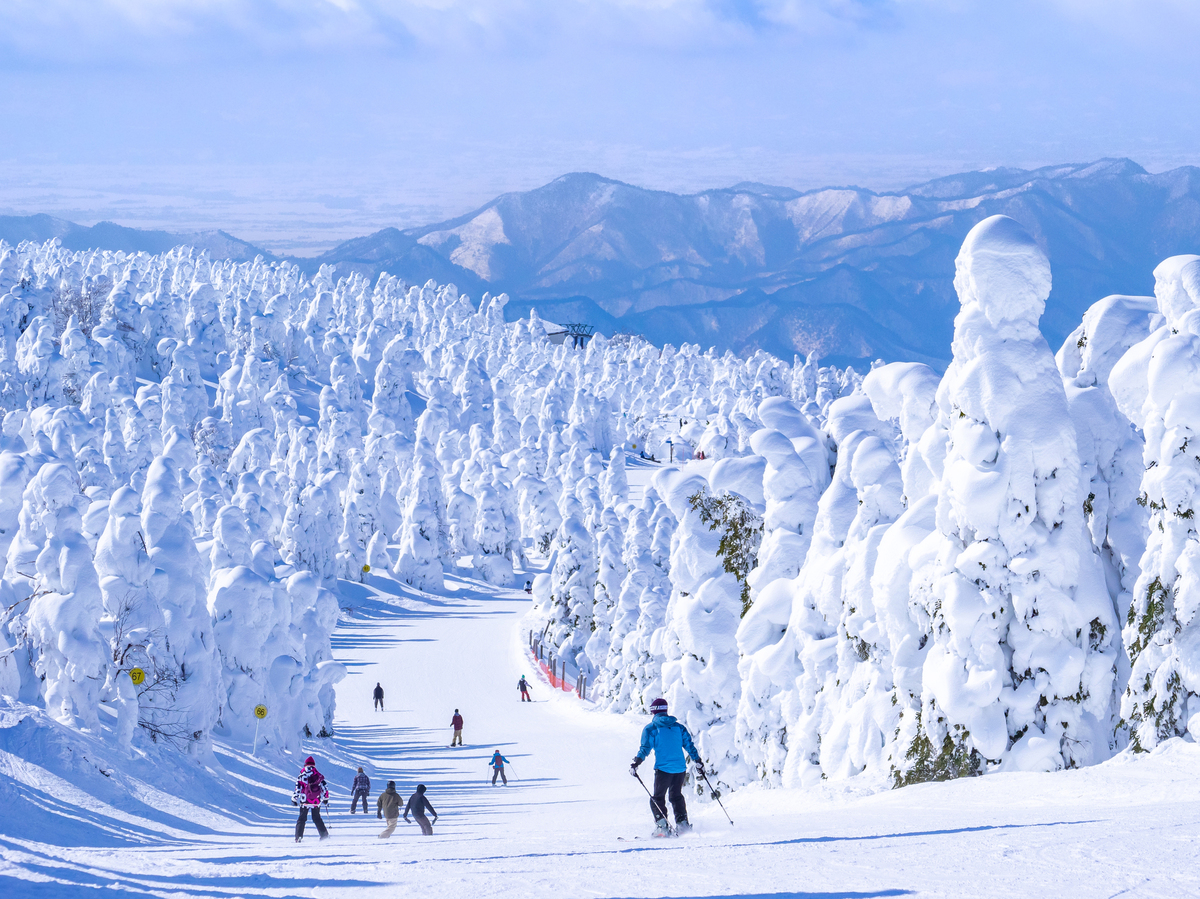
Table of Contents
- Direct connection from the airport! Convenient access by shuttle bus
- The central area, otherwise known as the core point of the Zao Onsen Ski Resort
- Spell-binding views of the Snow Monster Area stretching out before one’s eyes
- The Paradise Area is the perfect base for families
- The three gauntlets irresistible to those seeking a challenge
- Slopes so large, some even lose their way
- Make sure to rest your travel-weary body at the famous onsen!
- Make the most out of one of the largest ski resorts in Honshu!
Direct connection from the airport! Convenient access by shuttle bus

Take the Tohoku Shinkansen from Tokyo Station to Sendai Station (1 hour 40 minutes). Visitors can arrive by express bus from Sendai Station in 60 minutes. Alternatively, you can ride the Yamagata Shinkansen from Tokyo Station to Yamagata Station (2.5 hours). The bus from Yamagata Station takes 40 minutes.
Visitors arriving by car can take the Tohoku Expressway and then the Yamagata Expressway, finally getting off at the Yamagata-Zao Interchange before using the Nishi-Zao Kogen Line. The entire trip is expected to take around five hours. An express bus departs daily from Sendai Station to the Zao Onsen Ski Resort from late December to early March the following year.
There is also a direct bus service from the airport, making convenient access a prime selling point. Avoid any complicated procedures and catch some shut eye on the bus and you’ll be at the ski resort in no time.
The central area, otherwise known as the core point of the Zao Onsen Ski Resort

The central area is located on the reverse side of the 1,387 meter tall Mt. Torikabuto, and extends the length of the Dokkonuma Swamp. The snow on this north-facing slope is kept in excellent condition all season round. The top of the slope is connected to the Central slope, and the bottom is connected to the Diamond Valley slope past the Dokkonuma Swamp, making for a slope that essentially serves as the main entrance to Zao.
The Central Slope is positioned at the top. While all seven courses are short courses, the beech forest surrounding the course layout limits the impact felt by the prevailing winds and makes for an ideal location for beginner lessons. The long season length lasting all the way through to Golden Week in early May is another unique selling point.
The Diamond Valley lies at the base on the Dokkonuma Swamp. The surrounding beech forest reduces the effect of the wind and makes for a more tranquil environment, the perfect complement to the high quality snow conditions. The three courses, A, B and C, all offer abundant variety, making them ideal for beginner and intermediate lessons. The onsen district provides the perfect opportunity to ski all the way down the Takatori course from the Zao Sky Cable Chuo Kogen Station.
Spell-binding views of the Snow Monster Area stretching out before one’s eyes

The Snow Monster Area is the entrance to the longest course on the resort, spanning some eight kilometers. When first disembarking from the ropeway car the view of the frost-covered trees spanning out before your eyes is sure to take your breath away.
The Zangezaka Course is a famous course stretching from the Jizo-Sancho Station to the Paradise Junction, and is the start of an extremely long stretch of slope that leads onto the Juhyogen Course. This stretch drops from an elevation of 1,661 meters to 855 meters, making for an extremely varied downhill run.
The Juhyogen Course is an incline surrounded by frost-covered trees. Naturally, the snow quality is in the best condition - powder snow. On fine weather days the area is teeming with visitors hoping to catch a glimpse of the surrounding frost-covered forest, leading the congested ropeway exit to be referred to as Zao Ginza. If you’re at Zao in the winter, this is an unmissable destination even if you don’t fancy skiing.
The Paradise Area is the perfect base for families

The Paradise Area is located at the base of the Snow Monster Area, and consists of three slopes - the Paradise Slope, Shobunuma Slope and the Kotan Slope. This area boasts a large number of comparatively gentle slopes, making it popular among families.
The Paradise Slope starts from the end of the Zangezaka Course and is located on a higher part of the Zao Onsen Ski Resort. It boasts favorable snow conditions all season long, and is open to skiers until the Golden Week holidays in early May every year. The Karasawa Wall is one of the three hardest sections of the Zao Onsen Ski Resort, and at a maximum incline of 25 degrees it is not to be underestimated.
The Shobunuma Slope runs adjacent to the front of the Paradise Slope. It features a stretch with an average incline of 10 degrees at the start of the four kilometer long Ohira Course, which runs up to the Uenodai Slope, and offers the perfect environment for beginner and intermediate lessons. It is also known as the slope that links to the Renraku Course leading off from the Juhyogen Course.
The Kotan Slope is located to the left of the Paradise Slope, and is intended for beginner and intermediate skiers looking to advance their skills to the next level. On a fine day the majestic views of the alps-like Mt. Sampokojin, together with scenes of Mt. Asahi’s mountain range beyond the slopes are sure to take your breath away.
The three gauntlets irresistible to those seeking a challenge

While Zao presents a number of challenging courses, the hardest three are known as The Three Walls. These walls have spat out many an ill-prepared challenger. Those confident in their own abilities should check out this challenge at their own risk.
The first of these three is the Yokokura Wall. At a maximum incline of 38 degrees, this section is almost a vertical drop.
While only 250 meters in length, when peering down the steep gradient it seems as if it is going to swallow you whole. This area is off limits to snow compaction vehicles, resulting in uneven bumps which further raise the difficulty level. This is famous over Japan for its notorious difficulty, attracting confident skiers from far and wide to take it on.
Next is the Omori Wall, a section of slope irresistible for fans of mogul skiing. Positioned at the end of the Omori Giant Course, this broad section features a maximum incline of 32 degrees with a mogul slope that seems to stretch on forever. Depending on the course chosen, even confident skiers of an intermediate level may want to try their hand on this section of slope.
At a maximum incline of 25 degrees, the Karasawa Wall is a series of mogul bumps, with some even raising up to waist height, making it a tantalizing challenge for advanced skiers. This broad section of slope is off limits to snow compaction vehicles, making it possible to revel in the powder snow immediately after a patch of heavy snowfall. It’s possible to do long turns even in deep snow that rises up to the knee.
Slopes so large, some even lose their way

The ski resort first opened at the Zao Onsen in 1925. Ski lifts were first installed in 1941. This, being one of the largest ski resorts in Japan with many interconnecting ski lifts and ropeways, can result in skiers losing track of their bearings and ending up in places they didn’t intend.
With a map in your pocket, don’t be afraid of making mistakes as you ski around the slopes to your heart’s content. You can always get off somewhere else. The lift tickets can be used on any ski lift, so you can always reach your destination via some other route.
Make sure to rest your travel-weary body at the famous onsen!

Zao Onsen boasts an extremely long history. It was a bustling stop for worshippers traveling to pray to Zao Gongen in the Edo Period. Since then, the surrounding area has been built up to cater to numerous visitors from all over Japan, with the opening of the ski resort in 1925 marking the point at which the site became renowned as a general resort.
The onsen district at the Zao Onsen is home to three communal baths, and five hot spring facilities for visitors on a day trip. The hot springs are noted for their strongly acidic sulfur spring quality. This type of hot spring is known for increasing the amount of water in the body, and rejuvenating the skin and blood vessels.
In addition to promoting better blood circulation, this onsen also eliminates germs and strengthens the outer layer of the skin. This skin beautifying potential has attracted travelers far and wide, leading to the Zao Onsen being referred to as the “spring that makes people beautiful”. After a long day skiing, make sure to warm up your frigid body in these hot springs.
Make the most out of one of the largest ski resorts in Honshu!

The Zao Onsen Ski Resort is the oldest ski resort in Japan, attracting many skiers not just from Japan, but from abroad as well. The difference in elevation of around 800 meters, along with the surrounding frost-covered forest, helps create some stunning scenery that will take your breath away.
You could say this sightseeing spot has everything anyone could ever want, from those looking to hit the slopes, to those hoping to catch a glimpse of the beautiful rime forest and relax in the hot springs. As one of Japan’s premier ski destinations, the Zao Onsen Ski Resort is not to be missed.
Pricing information and schedule may not be up to date and are subject to change without notice. Please check before your trip.
Related ski resorts
Zao Onsen Ski Resort Yamagata Prefecture
| Courses | 26 |
| Lifts | 0 |
| Longest run distance | 10,000 m |
| Maximum gradient | 38 ° |
Hotel + lift pass
Lift ticket
Rentals
USD 5.74〜 (JPY 900〜)
Lessons




